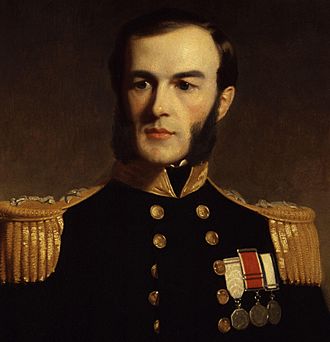Edward Augustus Inglefield facts for kids
Quick facts for kids
Sir
Edward Inglefield
|
|
|---|---|
 |
|
| North America and West Indies Station | |
| Commander-in-Chief 1 April 1878 – 27 November 1879 |
|
| Preceded by | Sir Astley Key |
| Succeeded by | Sir Leopold McClintock |
| Personal details | |
| Born |
Edward Augustus Inglefield
27 March 1820 Cheltenham, England |
| Died | 4 September 1894 (aged 74) South Kensington, England |
| Resting place | Kensal Green Cemetery |
| Spouse |
Eliza Johnston (m. 1857)
|
| Children | Edward Fitzmaurice Inglefield |
| Parent |
|
| Awards |
|
| Military service | |
| Branch | |
| Service years | 1832–1885 |
| Rank | Admiral |
| Wars | Crimean War |
Sir Edward Augustus Inglefield (born March 27, 1820 – died September 4, 1894) was an important officer in the Royal Navy, which is the United Kingdom's navy. He is best known for leading one of the search missions for the famous Arctic explorer John Franklin in the 1850s.
During his expeditions, Inglefield explored and mapped many new areas along the northern coast of Canada. These included places like Baffin Bay, Smith Sound, and Lancaster Sound.
He also invented some useful things for ships. These include a special steering system that used water pressure (called marine hydraulic steering gear) and a unique anchor design. A navy ship, HMS Inglefield, was named after him. Also, a region in Greenland called Inglefield Land and a bay called Inglefield Gulf carry his name.
Career
First Arctic Adventure
In July 1852, Inglefield began his search for Sir John Franklin. Franklin had disappeared seven years earlier while looking for the legendary Northwest Passage. Inglefield commanded a private steamship called Isabel, which belonged to Franklin's wife, Lady Franklin.
Once he reached the Arctic, Inglefield and his crew searched the west coast of Greenland. They also spotted and named Ellesmere Island after the president of the Royal Geographical Society.
Inglefield's ship sailed further into Smith Sound than anyone had recorded before. They also searched Jones Sound and landed at Beechey Island in Lancaster Sound. However, they found no signs of Franklin's missing expedition. Before winter arrived and forced them to leave, they also mapped a large part of Baffin Island's eastern coast.
Even though they didn't find Franklin, Inglefield was praised when he returned home. People were very impressed with the detailed maps his expedition had created. The Royal Geographical Society gave him a special award, the 1853 Patron's Medal. This was "for his adventurous survey of the coasts of Baffin Bay, Smith Sound and Lancaster Sound."
More Arctic Journeys
Inglefield went on two more trips to the Arctic. He sailed on HMS Phoenix to deliver supplies for another search for the Franklin expedition. This larger search was led by Sir Edward Belcher.
Inglefield returned from his first supply trip in 1853. He brought back Samuel Gurney Cresswell, who was the first officer to ever travel through the Northwest Passage. Cresswell's ship, the Investigator, had also been part of the search for Franklin. But it had started its journey from the western side of northern Canada.
In 1854, Inglefield returned to the Arctic. He found that Belcher's ships had been abandoned, except for one where all the crews had gathered. Most of these sailors returned to Britain with Inglefield.
Later Life
After his Arctic adventures, Inglefield joined the Crimean War. This war took place in the Black Sea. He was captain of HMS Firebrand and helped in the siege of Sevastopol. After the war, he commanded several other ships and continued to advance in his naval career.
In 1869, he became a rear admiral. Three years later, he was put in charge of the Malta Dockyard, a big naval base. He then became a vice admiral and later a full admiral. During this time, he was also knighted, which means he received the title "Sir." In 1878, he was made the Commander-in-Chief for the North America and West Indies Station. This meant he was the top naval officer in that region.
Inglefield retired from the navy in 1885. After retiring, he spent a lot of his time painting. His beautiful watercolour paintings of Arctic landscapes were shown in art galleries in London.
Family Life
On April 30, 1857, Edward Inglefield married Eliza Fanny Johnston. They had four sons and one daughter:
- Henry Beaufort Willmot Inglefield (1859–1926)
- Edward Fitzmaurice Inglefield (1861–1945), who also became a Royal Navy officer. He invented the Inglefield clip, a device used for quickly raising flags.
- Albany Otway Inglefield (1872–1873)
- Ernest Hallowell Inglefield (died 1879)
- Sybill Inglefield (died 1870)
Sir Edward Inglefield passed away in 1894. He was buried in Kensal Green Cemetery in west London.


